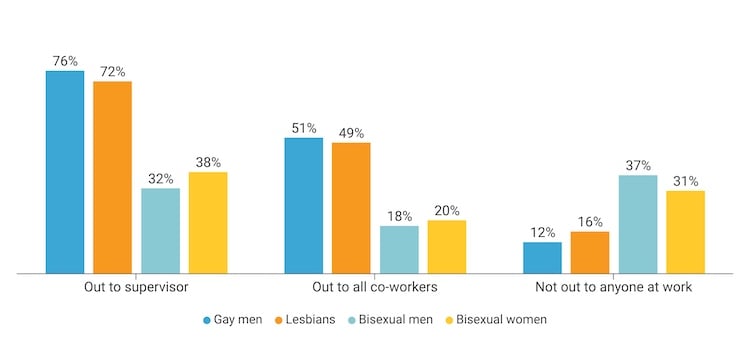
Bisexual men and women experience less workplace discrimination than their gay and lesbian colleagues, but that figure could be due to more bisexual people are in the closet at the office, according to a new study.
Bisexual men and women experience less workplace discrimination than their gay and lesbian colleagues, but that figure could be due to more bisexual people are in the closet at the office, according to a study.
Findings from a report from the Williams Institute at the UCLA School of Law, “The Role of Sexual Orientation and Gender in Workplace Experiences of Cisgender LGB Employees,” show that 36% of cisgender bisexual employees reported being out to their supervisors and only 19% reported being out to all their coworkers.
On the other hand, 50% of gays and lesbians were out to their coworkers, and 75% were out to their supervisors.
The report was compiled by analyzing data in an anonymous survey of 935 LGB adults conducted between May 5-16, 2021 who were in the workforce the week of March 1, 2020.
Overall, the report says that cisgender bisexual employees are significantly less likely to report experiencing discrimination and harassment in the workplace than cisgender gay and lesbian employees.
However, their analysis suggests that higher rates of concealing LGB identity among employees may mask the extent to which bisexual employees experience unfair treatment at work.
For example, 34% of gay and lesbian workers reported discrimination in the workplace compared to 24% of their bisexual counterparts.
However, that number narrowed when being out in the workplace is considered, 33% of out bisexual workers reporting discrimination compared to 37% of out gay and lesbian workers.
The authors said that their findings suggest that LGB employees “should not be treated as a monolithic group when researching, understanding, and addressing their workplace experiences. They vary in the degrees to which they are out in the workplace and engage in strategies to downplay their sexual orientation.
“These findings suggest that they also face different types and patterns of workplace discrimination and harassment,” the authors said.
“More specifically, these findings suggest that gay and bisexual men may face unique and intersecting forms of stigma associated with their gender and sexual orientation and additional pressure to conceal their LGB identity at work,” the authors said.
Other key findings
The report also found that bisexual men suffered more workplace discrimination than bisexual women.
- 46% of bisexual men reported being fired or not hired due to their sexual identity
- 27% of bisexual women reported similar experiences.
- 60% of bi men reported instances of workplace harassment over their careers
- 38% of bi women reported instances of workplace harassment over their careers
Many cisgender LGB employees also reported engaging in “covering” behaviors to avoid harassment or discrimination at work.
- About 60% of gay men and lesbian employees and bisexual employees reported that they avoided social events or avoided talking about their lives at work in order to avoid discrimination and harassment.
- 26% of bisexual men and women said they changed their appearance at work to cover their sexual orientation
- 18% of gay and lesbian employees said they changed their appearance at work to cover their sexual orientation.
- Gay and bisexual men were more likely than bisexual women to say they avoided social events, hid family photos, and did not bring family to work events in order to avoid discrimination.
